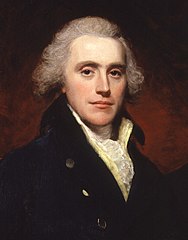Henry Addington
 | |
| Data i miejsce urodzenia | 30 maja 1757 |
|---|---|
| Data i miejsce śmierci | 15 lutego 1844 |
| Premier Wielkiej Brytanii | |
| Okres | od 17 marca 1801 |
| Przynależność polityczna | |
| Poprzednik | |
| Następca | |

Henry Addington, 1. wicehrabia Sidmouth (ur. 30 maja 1757 w Londynie, zm. 15 lutego 1844 w Richmond, Surrey) – brytyjski polityk, członek stronnictwa torysów, od 1784 r. członek Izby Gmin, a od 1805 r. Izby Lordów, w latach 1789–1801 speaker Izby Gmin, premier w latach 1801–1804.
Życiorys
Był synem Anthony’ego Addingtona i Mary Hiley, córki wielebnego Havilanda Johna Hileya. Jego ojciec był lekarzem lorda Chathama, więc Henry przyjaźnił się w dzieciństwie z jego synem, Williamem. Addington pobierał nauki w Winchester School oraz w Brasenose College na Uniwersytecie Oksfordzkim. Następnie studiował prawo w Lincoln’s Inn.
W 1784 r. został wybrany do Izby Gmin jako reprezentant okręgu Devizes. W 1789 r. został speakerem Izby Gmin. W marcu 1801 r. do dymisji podał się gabinet Williama Pitta, któremu nie udało się przeforsować projektu równouprawnienia katolików. Na następcę Pitta został wybrany Addington.
Za czasów Addingtona zawarto pokój z Francją (traktat w Amiens, 1802). Wkrótce jednak wojna wybuchła na nowo i Addington został zastąpiony przez Pitta. W 1805 r. otrzymał tytuł 1. wicehrabiego Sidmouth i zasiadł w Izbie Lordów. Od stycznia do lipca 1805 r. był Lordem Przewodniczącym Rady w drugim gabinecie Pitta. W Gabinecie Wszystkich Talentów w latach 1806-1807 pełnił najpierw funkcję Lorda Tajnej Pieczęci, a następnie Lorda Przewodniczącego Rady.
Sidmouth powrócił do gabinetu w 1812 r., kiedy został Lordem Przewodniczącym Rady w rządzie Percevala. Kiedy jeszcze w tym samym roku nowym premierem został lord Liverpool, Sidmouth otrzymał tekę ministra spraw wewnętrznych. Na tym stanowisku walczył z radykalną opozycją, odpowiadał za zawieszenie Habeas Corpus Act w 1817 r., masakrę Peterloo w 1819 r. oraz represyjne Sześć Aktów z tego samego roku.
W 1822 r. został zastąpiony w Ministerstwie Spraw Wewnętrznych przez Roberta Peela. Pozostał aktywnym członkiem Izby Lordów – sprzeciwiał się uznaniu przez Wielką Brytanię republik południowoamerykańskich, równouprawnieniu katolików i reformie wyborczej. Zmarł w 1844 r.
Był dwukrotnie żonaty i miał czterech synów i cztery córki. Tytuł parowski odziedziczył jego syn z pierwszego małżeństwa, William.
Zobacz też
Linki zewnętrzne
- Royal Berkshire History
- The Victorian Web
- 1911encyclopedia.org. 1911encyclopedia.org. [zarchiwizowane z tego adresu (2013-07-27)].
- Spartacus Educational
- Profil na stronach 10 Downing Street
Media użyte na tej stronie
Britannia between Death and the Doctor's
Js Gillray inv. & fect.
SUMMARY: A faint Britannia seated on bed with three "doctors," William Pitt kicking Henry Addington and stepping on Charles James Fox. The figure of death, with Napoleon's head, strides from behind bed curtains.
MEDIUM: 1 print : etching, hand-colored.
CREATED/PUBLISHED: [London] : pubd. by H. Humphrey, 1804 May 20th.
According to Wright & Evans, Historical and Descriptive Account of the Caricatures of James Gillray (1851, OCLC 59510372), p. 243, "On Pitt's return to office in 1804. Doctor Addington's course of treatment has nearly thrown his patient into the power of political death, personified in her arch-enemy Napoleon, and she is only relieved by the sudden return of her old physician. Pitt is represented as kicking Addington out of the House, and has overturned a phial in Addington's hand, labelled 'Composing Draft.' Pitt holds a bottle of 'Constitutional Restorative' in his hand, and 'The Art of Restoring Health' is hanging out of his pocket. He is treading upon Fox's prostrate body. By Fox's side are 'Whig Pills,' and in his uplifted hand is 'Republican Balsam.'"Henry Addington, 1st Viscount Sidmouth's signature.
Portret Robert Banks Jenkinson (1770–1828)
The portcullis design is recorded as the work of Charles Barry in 1834 and is used on many Royal commissions such as on the Great Bell ("Big Ben").
As well as wide use of the portcullis design with varied supporting emblems, this specific version with the crown has been used by HM Customs and Excise "for some centuries."
There was a formal grant to both Houses of Parliament by Queen Elizabeth II in 1996. A grant for official use is not a claim of copyright. It is not possible to retrospectively claim copyright of an emblem or logo where publication and usage dates back more than two centuries.
This information is based on House of Commons Information Office paper "The Portcullis", published in 2010.Autor: Sodacan, Licencja: CC BY-SA 3.0
Royal Coat of Arms of the United Kingdom of Great Britain and Northern Ireland in the style used by the Government of King Charles III from 2022 to the present (as used in all places except Scotland).
| “ | Quarterly, First and Fourth Gules three lions passant guardant in pale Or armed and langued Azure (for England), Second quarter Or a lion rampant within a double tressure flory counter-flory Gules (for Scotland), Third quarter Azure a harp Or stringed Argent (for Ireland), the whole surrounded by the Garter; for a Crest, the imperial crown Proper; for Supporters, dexter a lion rampant guardant Or crowned as the Crest, sinister a unicorn Argent armed, crined and unguled Proper, gorged with a coronet Or composed of crosses patée and fleurs de lys a chain affixed thereto passing between the forelegs and reflexed over the back also Or; Motto 'Dieu et mon Droit’ ('God and my Right') below the shield. | ” |
- PINCHES, J.H & R.V., The Royal Heraldry of England, 1974, Heraldry Today.
Portrait of Spencer Perceval (1762-1812), Prime Minister of Great Britain
















